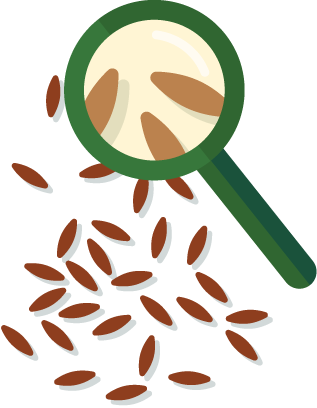
Red rice is a whole grain with a reddish-brown hue and a nutty, slightly earthy flavour. It has a firmer texture compared to white or brown rice. Red rice is commonly used in South Asian and Southeast Asian cuisines, often featured in dishes like curries, rice salads, and as a base for stir-fries.
To enhance the flavour of red rice, consider toasting it in a dry pan for a few minutes before cooking. Using broth instead of water can also add more richness to the dish.

Nutritionally, red rice is high in phosphorus, copper, and niacin (vitamin B3). It’s also a source of fibre, magnesium, iron, and thiamine (vitamin B1). It also contains antioxidants, particularly proanthocyanidins, which give the rice its reddish colour. Red rice is naturally gluten-free, making it suitable for those with gluten intolerance or coeliac disease.
Proanthocyanidins are molecules with strong antioxidant properties, which help protect cells from damage and reduce the risk of chronic diseases. The fibre in red rice aids also aids in digestions and helps maintain healthy cholesterol levels. Regularly eating red rice can support heart health and provide sustained energy due to its complex carbohydrates.

Toggle with the tables below to compare their nutritional content per 100 g (both cooked and uncooked) and per average portion size. You might be surprised by the differences!
| Grains | Kcal | Protein | Fat | Saturated fat | Carbohydrates | Fibre |
|---|---|---|---|---|---|---|
| Red rice, Per 100 g, uncooked | 356.00 | 7 | 2 | 0 | 80 | 4 |
| White rice, Per 100 g, uncooked | 352.00 | 7 | 1 | 0 | 78 | 1 |
Whole grains are all packed with carbohydrates and dietary fibre (which is a type of carbohydrate) and are naturally low in (saturated) fat. Fibre is important for our health and the prevention of many chronic diseases. That’s why the European Food Safety Authority (EFSA) recommends we eat at least 25 g of fibre per day. Sometimes, you might see whole grains labelled as ‘high in fibre’ or ‘source of fibre’ – but what does that really mean?
| Grains (% of DRV) | Calcium | Magnesium | Phosphorus | Potassium | Iron | Zinc | Copper | Vit. B1 | Vit. B2 | Vit. B3 | Vit. B6 | Folate |
|---|---|---|---|---|---|---|---|---|---|---|---|---|
| Red rice, per 100 g, uncooked | 1.88 | 28.27 | 44.86 | 12.10 | 15.36 | 15.00 | 37.00 | 22.73 | 5.00 | 46.88 | 8.57 | 6.97 |
| Red rice, per portion, uncooked | 1.31 | 19.79 | 31.40 | 8.47 | 10.75 | 10.50 | 25.90 | 15.91 | 3.50 | 32.81 | 6.00 | 4.88 |
| White rice, per 100 g, uncooked | 1.25 | 3.47 | 14.29 | 5.00 | 2.86 | 18.00 | 37.00 | 3.64 | 2.14 | 6.25 | 8.57 | 6.06 |
| White rice, per portion, uncooked | 0.88 | 2.43 | 10.00 | 3.50 | 2.00 | 12.60 | 25.90 | 2.55 | 1.50 | 4.38 | 6.00 | 4.24 |
% of DRV stands for dietary reference value. DRV stands for dietary reference value. These values estimate how much of a nutrient most healthy people in Europe need each day. Ideally, we should aim to reach 100% of these values daily. Each vitamin and mineral has their own DRV, as set by EFSA.
You might have heard that whole grains are ‘high in,’ ‘rich in,’ or ‘source of’ a certain vitamin or mineral. These term are regulated by EFSA and products must meet specific rules to be considered as such. Here’s how to interpret these contributions:

Store in an airtight container in a cool, dry place. Follow the instructions on the packaging to keep the food good for as long as possible.
Red rice has a best-before date, meaning that it can often be eaten after that date has passed. If they look, smell and taste good, and the packaging is also intact, it will most likely be safe.

Follow the instructions on the packaging to cook wild rice. Cooking times can vary depending on the variety and type of red rice.
As a general rule of thumb, rinse the rice when it is raw. Use plenty of water to cook the rice (similar to how you would boil pasta). Bring to boil, then simmer for 25-45 minutes and drain the excess water. Rinse the cooked rice again. This 3-step method helps to remove some of the naturally present arsenic in rice. Chronic intake of arsenic via diet and/or drinking water can cause adverse health effects, including cancer of the skin, bladder, and lungs.

White rice is not a whole grain. It has been stripped of its bran and germ, leaving only the starchy endosperm. This process removes many nutrients, including fibre and essential vitamins and minerals.
Learn to identify whole grain products, cook delicious meals, find practical tips for a smooth, gradual switch, and much more!